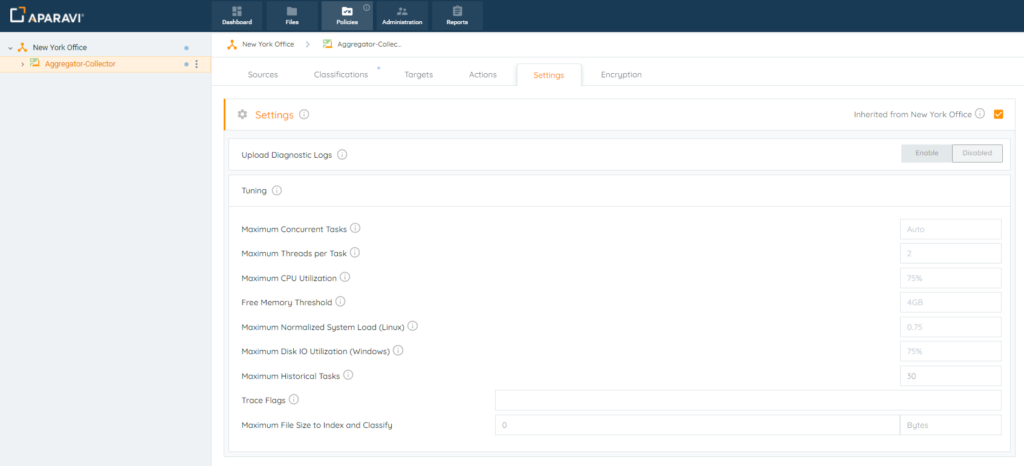How Can We Help?
Search for answers or browse our knowledge base.
Settings Configuration
Purpose
Settings enable or disable functionality for features in the system. The tunings section provides settings which allow you to make adjustments that affect the runtime and resource consumption of both Aggregators and Collectors.
Usage
To access Settings, click Policies from the ribbon menu, then click the Settings tab just below.
On initial view, all options are grayed out because policies are inherited from the root organization. The recommendation is to keep the system default. However, to customize the application, clear the “Inherited from Organizations” checkbox shown in the upper right corner of the Settings page which will allow you to change any settings. Remember to click ‘Save All Changes’ button shown at the lower left to apply any changes.

Feature Settings
Upload Diagnostic Logs
Upload Diagnostics Logs allows for additional technical analysis of problem situations. Once enabled, logs and engine crash details will automatically be sent to the hosted platform for analysis.
Tuning
Maximum Concurrent Tasks
The maximum number of tasks such as scanning, indexing, and classification that are allowed to run simultaneously. The higher the number, the quicker the processes will take, but more resources will be consumed.
Maximum Threads per Task
The maximum number of concurrent processes per task that are allowed to run simultaneously.
Maximum CPU Utilization
Limits the CPU consumption of Aparavi processes. Before a new task starts, the CPU consumption on the Aggregator or Collector must be below this threshold else the task will not start.
Free memory Threshold
Limits the memory / RAM consumption of Aparavi processes. Before a new task starts, the memory consumption on the Aggregator or Collector must be below this threshold else the task will not start.
Maximum Normalized System Load (Linux)
Limits the CPU consumption of Aparavi processes. Before a new task starts, the CPU consumption on the Aggregator or Collector must be below this threshold else the task will not start.
Maximum Normalized System Load (Windows)
Limits the disk utilization of Aparavi processes. Before a new task starts, the IO utilization on the Aggregator or Collector must be below this threshold else the task will not start.
Maximum Historical Tasks
The number of historical tasks that will be saved on the Aggregator. The Dashboard Status widget uses the historical task information to visualize task history. Once the limit is reached, older task history will be removed.
Trace Flags
Trace Flags allow technical administrators to update logging levels for specific tasks such as engine, network, and queuing. The additional logging provides more information to help troubleshoot issues.